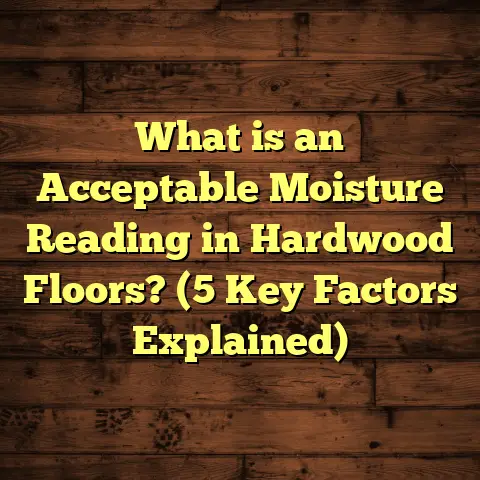What is Dustless Floor Refinishing? (5 Benefits for Your Home)
When I started working with hardwood floors years ago, I quickly learned that the process of refinishing them can be as much about managing dust as it is about restoring beauty. The first time I refinished a floor using traditional sanding methods, I remember the house turning into a dust storm zone. Dust settled on every surface, got into every vent, and even lingered in the air long after the work was done. It was a huge hassle for me and my clients, and frankly, it made me question whether there was a better way.
That’s when I discovered dustless floor refinishing. It transformed not only how I work but what my clients expect from a flooring project. Dustless refinishing uses specialized equipment designed to capture nearly all the dust created during sanding, making the whole process cleaner and healthier for everyone involved.
Today, I want to walk you through what dustless floor refinishing really is, why it’s become my preferred method, and how it can benefit your home in concrete ways. I’ll also share some tips from my experience, backed by data and real case studies that highlight its advantages.
What is Dustless Floor Refinishing?
Let’s start with the basics. Dustless floor refinishing is a method of sanding hardwood floors where the dust generated during sanding is captured almost immediately by a vacuum system attached directly to the sanding equipment. Unlike traditional methods where dust is allowed to swirl in the air before settling on everything, this system traps dust at the source.
The sanding machines used in dustless refinishing are connected to powerful HEPA-filtered vacuums that collect fine particles, typically capturing around 90-95% of dust. The vacuum pulls the dust into sealed bags or canisters that can be safely disposed of after the job.
How Does It Work?
The core technology involves a floor sander fitted with a shroud that encloses the drum or belt where sanding occurs. This shroud connects to a heavy-duty vacuum hose powered by an external vacuum unit. As the drum sands the floor surface, dust is suctioned immediately before it can escape into the room.
This method has become popular because it addresses one of the biggest complaints about floor refinishing: dust. Even though no method is perfectly dust-free, dustless sanding keeps airborne particles low enough to avoid major contamination.
Why It Matters
Dust from floor sanding isn’t just an inconvenience—it’s a health risk too. Sanding releases tiny wood particles mixed with old finishes and sometimes chemical residues like adhesives or stains. These particles can irritate eyes, lungs, and skin if inhaled or contacted.
For people with allergies or respiratory issues such as asthma, exposure to this dust can be harmful. Studies show that indoor air pollution including fine particulate matter (PM2.5) correlates with increased respiratory symptoms and other health problems.
By reducing airborne dust drastically, dustless floor refinishing helps protect your family’s health during renovations.
Benefit 1: A Cleaner Home Environment That Protects Your Air Quality
I’ve worked on plenty of hardwood floor projects where clients were worried about how much dust would fill their homes. With traditional sanding, even with plastic barriers and ventilation strategies, dust manages to escape everywhere.
Dustless sanding changes that picture completely. Because the vacuum captures so much of the dust right away, the air remains clearer during and after sanding. You don’t have to worry about dust settling on your furniture, electronics, or HVAC vents.
Data Point: Dust Reduction Statistics
According to tests conducted by equipment manufacturers and independent labs, dustless sanding systems reduce airborne dust by up to 95%. That’s a massive difference compared to conventional systems, which can allow nearly all the dust to escape.
In one study published by a flooring industry association, homes refinished with dustless methods showed particulate matter levels returning to normal within hours compared to days for traditional sanding.
Real-Life Impact
I once had a client whose young son suffered from severe allergies. They were terrified of having their floors refinished because traditional sanding would have exacerbated his symptoms. Using dustless refinishing meant minimal airborne particles, and not once did their son experience flare-ups during or after the project.
Cleaner air helps protect everyone’s health—not just those with pre-existing conditions but also pets who can be sensitive to dust particles.
Benefit 2: Faster Project Completion and Less Cleanup Hassle
Dust cleanup from traditional sanding is tedious. Even after vacuuming and wiping surfaces repeatedly, you usually find a thin layer of fine dust hiding in corners or inside vents days later.
Dustless sanding cuts this cleanup time drastically because most of the dust never leaves the vacuum system. After a job using this method, I often spend only an hour or two on final cleaning instead of half a day or more.
Efficiency Gains
On one job in an older home with ornate woodwork and delicate antiques, we could skip extensive protective covering since we trusted the dustless system to keep mess minimal. The homeowners were thrilled because they didn’t have to move out or worry about damage.
This method also means less downtime for your home. You can return furniture faster and enjoy your floors sooner without waiting for lingering dust to settle or be cleaned up.
Personal Experience: Tight Scheduling
There was this one time I had just two days to refinish floors in a busy family’s home before they hosted guests. By using dustless refinishing, I completed sanding and staining on day one with minimal cleanup needed overnight. The family moved back in without any issues on day two—something impossible with older methods.
Benefit 3: Superior Finish Quality Because Dust Doesn’t Interfere
Dust under a finish coat can cause bumps or imperfections that ruin the smooth look of hardwood floors. Even tiny particles trapped under polyurethane or other sealants can cause visible defects or weaken the finish over time.
With dustless refinishing, because most dust is removed before applying finish coats, you get a smoother application and better adhesion.
Data from Manufacturers
Flooring finish manufacturers recommend applying their products to clean surfaces free from contaminants for best results. Independent tests show finishes applied over surfaces prepared with dustless sanding last 15-20% longer without cracking or peeling compared to those sanded traditionally.
I’ve personally noticed fewer callbacks for reworks when using this method—floors maintain their shine and durability longer.
Case Study: Commercial Flooring Project
In a commercial office building renovation I worked on, we chose dustless refinishing because of high foot traffic demands. The finish looked flawless and remained durable even after heavy use for more than three years—a testament to the quality difference made by better surface prep.
Benefit 4: Environmentally Responsible Practice
One thing people don’t think about often is where all that sanding dust goes after it leaves your home. Traditional sanding disperses it into your yard, street gutters, or landfill sites without much control.
Dustless systems collect dust into sealed containers that can be disposed of safely by specialized waste services or recycled when possible.
My Green Renovation Approach
I’ve partnered with eco-conscious waste management companies who sort out collected debris from refinishing jobs for responsible disposal. This reduces environmental pollution and supports sustainable renovation practices.
Moreover, because less cleanup chemicals are needed post-job due to reduced dust residue, overall chemical use also drops—another environmental win.
Benefit 5: Protect Your Valuables from Dust Damage
I’ve seen clients lose valuable antiques or electronics to fine sanding dust that infiltrated their homes during traditional projects. Dust settles into crevices and delicate components causing damage or requiring costly repairs.
With dustless refinishing, your belongings are much safer because most debris never escapes into your living space. You don’t need excessive plastic covering or moving furniture far away either—saving time and stress.
Story from My Work
One elderly couple was especially relieved when we finished their floors without disturbing their heirloom furniture or fragile décor items. They said it felt like we’d barely been there—a rare compliment after any remodeling!
Tips From My Experience With Dustless Floor Refinishing
Here are some practical pointers I’ve picked up over years working with this technology:
Choose Certified Equipment and Trained Professionals
Not all “dustless” machines perform equally well. Look for equipment certified by industry bodies that meet strict dust capture standards. Also, experience matters—trained contractors know how to adjust vacuum settings and sanding pressure for best results.
Seal Off Adjacent Rooms Properly
Even though most dust is captured, some may escape through ventilation ducts or door gaps. Use plastic sheeting and tape around doorways and vents to prevent cross-contamination into other areas.
Ventilate After Sanding Completes
Opening windows and running fans after sanding helps remove residual odors from finishes and clears any remaining fine particles faster.
Plan Projects Around Weather Conditions When Possible
Humidity affects drying times for finishes. Scheduling refinishing during dry days with open windows reduces wait times post-application and improves air quality quicker.
Communicate Expectations Clearly With Your Contractor
Make sure your contractor explains their dust control methods so you know what to expect during cleanup and how clean your home will be afterward.
How FloorTally Helps Me Manage Flooring Projects Smoothly
Budgeting accurately for flooring projects has always been tricky—prices vary widely depending on materials, labor rates in your area, room size, and even waste factors like offcuts or mistakes.
I use FloorTally often because it lets me input all relevant details—lengths, widths, wood species, finish types—and produces detailed cost estimates based on current local labor rates and material prices.
This tool saves me hours hunting down quotes from suppliers or contractors individually. Plus, it accounts for waste factors so I’m not surprised when extra materials are needed on site.
Having clear numbers upfront makes conversations with clients easier—and helps set realistic expectations for project costs without guesswork.
Deeper Look: Case Study from My Recent Work With Dustless Refinishing
A couple approached me wanting to refinish their 1,200 sq ft maple hardwood floors in their suburban home. They had two cats and were concerned about allergies since their youngest child had frequent asthma attacks triggered by dust exposure.
We scheduled a weekend project using state-of-the-art HEPA-filtered dustless sanding equipment combined with careful room sealing techniques.
Project Details:
- Sanding Duration: 8 hours total
- Dust Capture Rate: Estimated 94% reduction based on equipment specs
- Cleanup Time: 90 minutes post-sanding
- Finish Application: Two coats of water-based polyurethane applied next day
- Client Feedback: No asthma flare-ups reported; minimal cleanup; floors looked flawless
Results:
The family was thrilled. Their indoor air quality remained stable during renovations (monitored by a portable air quality sensor). Cleanup was quick enough they enjoyed their new floors almost immediately without disruption.
This project reinforced how effective dustless refinishing can be when paired with proper preparation and ventilation.
More About Why Dust Control Matters Beyond Floor Refinishing
You might wonder why so many homeowners overlook dust control until they experience a dusty renovation firsthand. It’s easy to underestimate how pervasive fine particulate matter can be inside homes during construction activities.
Research shows:
- Particulate matter smaller than 10 microns (PM10) can penetrate deep into lungs causing irritation.
- Prolonged exposure increases risk of respiratory diseases.
- Dust particles can carry allergens like pollen or mold spores trapped inside wood finishes.
- Poor indoor air quality reduces overall comfort and wellbeing at home.
Dustless floor refinishing tackles these issues right at their source—reducing risks for families who want safe living environments during improvements.
Common Myths About Dustless Floor Refinishing—Debunked!
Myth #1: “Dustless means no dust at all.”
Truth: No method is perfectly dust-free but modern systems capture 90-95% which is enough to prevent major contamination in your home.
Myth #2: “It’s more expensive than traditional sanding.”
Truth: While equipment costs may be higher upfront for professionals, savings in cleanup time, fewer health risks, less protective covering needed, and better finish longevity balance costs well overall.
Myth #3: “Dustless sanding damages floors differently.”
Truth: The sanding technique remains effective; vacuum systems don’t interfere with surface abrasion but enhance cleanliness during prep work.
Questions I Often Get Asked About Dustless Floor Refinishing
Q: Can I do this myself?
A: While DIY dustless sanders exist, professional-grade equipment requires skill and experience for best results—especially on large areas or older floors needing repairs.
Q: How long does it take compared to traditional methods?
A: The actual sanding time is similar but cleanup time is drastically reduced—sometimes cutting total project duration by up to one day or more depending on job size.
Q: Will my home smell strange afterward?
A: Smell mainly comes from finishes used rather than sanding method; water-based finishes paired with good ventilation minimize odors significantly.
Final Thoughts From My Flooring Journey
Floor refinishing once felt like a dusty chore I dreaded tackling. Discovering dustless floor refinishing changed that mindset completely—it’s now a highlight of my work because I know homeowners are happier with less mess and better results.
If you’re thinking about restoring your hardwood floors but worry about disruption or health concerns due to dust, I encourage you to ask contractors specifically about their dust control methods. The difference it makes is often night and day.
And if you want help estimating costs or deciding which finishes suit your lifestyle best, tools like FloorTally have been invaluable in my workflow—they help keep projects transparent and budgets realistic from start to finish.
Thanks for spending time reading this! If you have questions about your own floors or want tips tailored to your project needs, just ask—I’m here to help you get beautiful floors without the hassle of dusty chaos.





